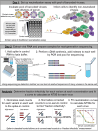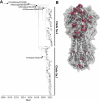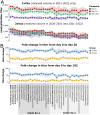This is a preprint.
High-throughput sequencing-based neutralization assay reveals how repeated vaccinations impact titers to recent human H1N1 influenza strains
- PMID: 38496577
- PMCID: PMC10942427
- DOI: 10.1101/2024.03.08.584176
High-throughput sequencing-based neutralization assay reveals how repeated vaccinations impact titers to recent human H1N1 influenza strains
Update in
-
High-throughput sequencing-based neutralization assay reveals how repeated vaccinations impact titers to recent human H1N1 influenza strains.J Virol. 2024 Oct 22;98(10):e0068924. doi: 10.1128/jvi.00689-24. Epub 2024 Sep 24. J Virol. 2024. PMID: 39315814 Free PMC article.
Abstract
The high genetic diversity of influenza viruses means that traditional serological assays have too low throughput to measure serum antibody neutralization titers against all relevant strains. To overcome this challenge, we have developed a sequencing-based neutralization assay that simultaneously measures titers against many viral strains using small serum volumes via a workflow similar to traditional neutralization assays. The key innovation is to incorporate unique nucleotide barcodes into the hemagglutinin (HA) genomic segment, and then pool viruses with numerous different barcoded HA variants and quantify infectivity of all of them simultaneously using next-generation sequencing. With this approach, a single researcher performed the equivalent of 2,880 traditional neutralization assays (80 serum samples against 36 viral strains) in approximately one month. We applied the sequencing-based assay to quantify the impact of influenza vaccination on neutralization titers against recent human H1N1 strains for individuals who had or had not also received a vaccine in the previous year. We found that the viral strain specificities of the neutralizing antibodies elicited by vaccination vary among individuals, and that vaccination induced a smaller increase in titers for individuals who had also received a vaccine the previous year-although the titers six months after vaccination were similar in individuals with and without the previous-year vaccination. We also identified a subset of individuals with low titers to a subclade of recent H1N1 even after vaccination. This study demonstrates the utility of high-throughput sequencing-based neutralization assays that enable titers to be simultaneously measured against many different viral strains. We provide a detailed experimental protocol (DOI: https://dx.doi.org/10.17504/protocols.io.kqdg3xdmpg25/v1) and a computational pipeline (https://github.com/jbloomlab/seqneut-pipeline) for the sequencing-based neutralization assays to facilitate the use of this method by others.
Conflict of interest statement
Competing Interests JDB is on the scientific advisory boards of Apriori Bio, Aerium Therapeutics, Invivyd, and the Vaccine Company. JDB and ANL receive royalty payments as inventors on Fred Hutch licensed patents related to incorporation of barcodes into the influenza genome and viral deep mutational scanning. BJC has consulted for AstraZeneca, Fosun Pharma, GlaxoSmithKline, Haleon, Moderna, Novavax, Pfizer, Roche, and Sanofi Pasteur.
Figures









References
-
- Smith DJ, Lapedes AS, De Jong JC, Bestebroer TM, Rimmelzwaan GF, Osterhaus ADME, et al. Mapping the antigenic and genetic evolution of influenza virus. Science (80- ). 2004. Jul 16;305(5682):371–6. - PubMed
-
- Ohmit SE, Petrie JG, Cross RT, Johnson E, Monto AS. Influenza hemagglutination-inhibition antibody titer as a correlate of vaccine-induced protection. J Infect Dis. 2011;204(12). - PubMed
-
- Kim K, Gouma S, Vieira MC, Weirick ME, Hensley SE, Cobey S. Measures of population immunity can predict the dominant clade of influenza A (H3N2) and reveal age-associated differences in susceptibility and specificity. medRxiv. 2023;
Publication types
Grants and funding
LinkOut - more resources
Full Text Sources
